#Silvery lutung
Text

Silvery lutung (Trachypithecus cristatux)
This arboreal monkey is found in wetland forests, including mangroves, coasts, rivers, and swamps, across several Indonesian islands. They are far more specialised for eating plants than most primates, with ridged teeth and a multi-chambered stomach. Juvenile silvery lutungs are bright orange, a stark contrast to their adult grey colour.
#markhors-menagerie#primates#old world monkeys#monkeys#animal facts#fun facts#animals#biology#langur#silvery lutung
22 notes
·
View notes
Text








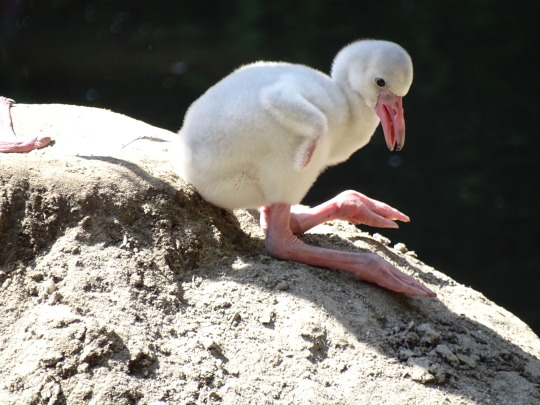


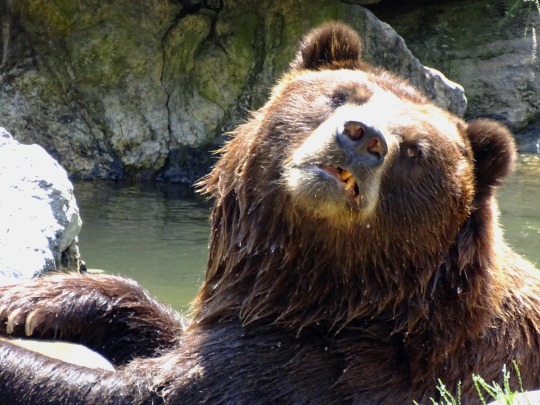



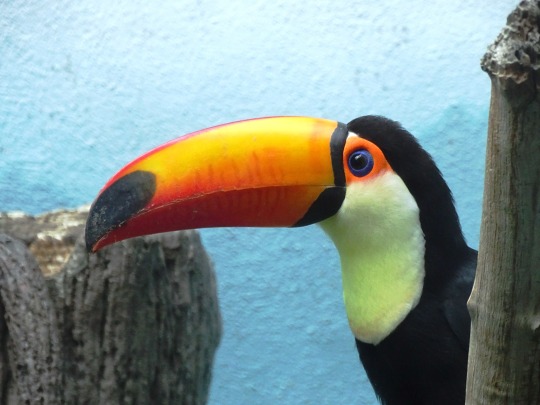

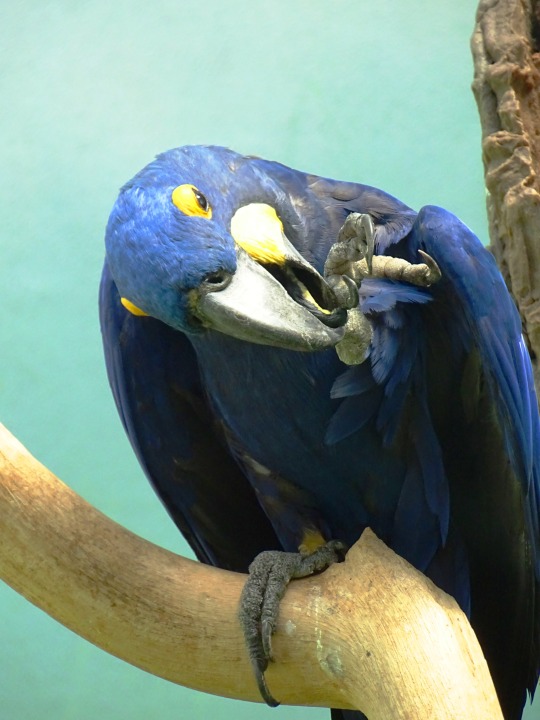



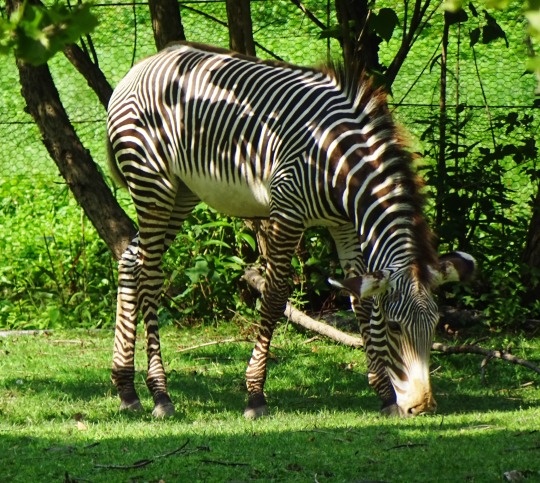
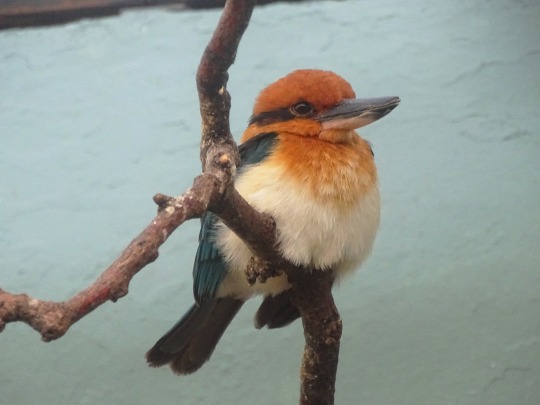

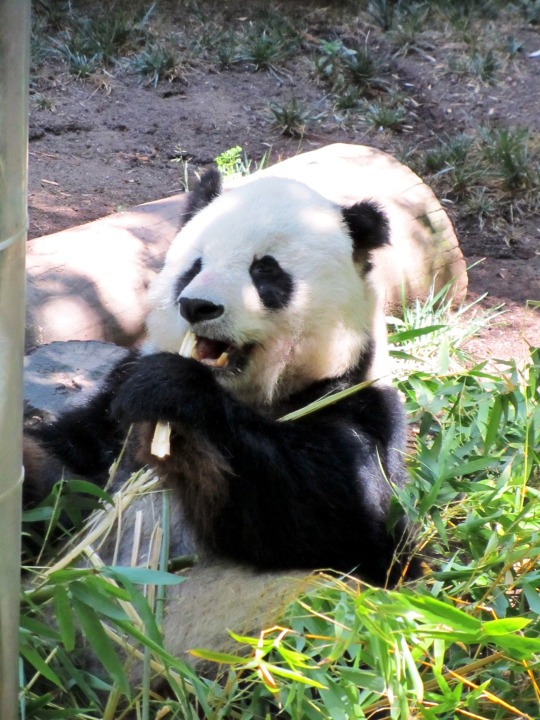
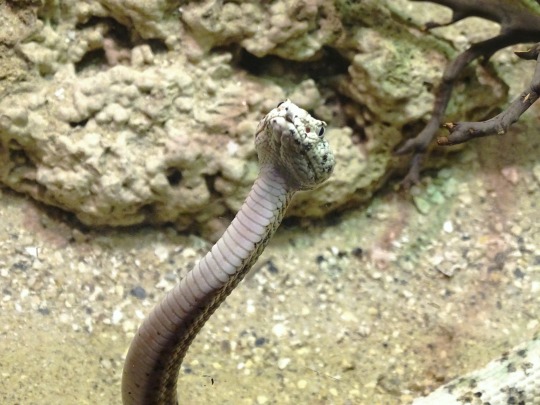


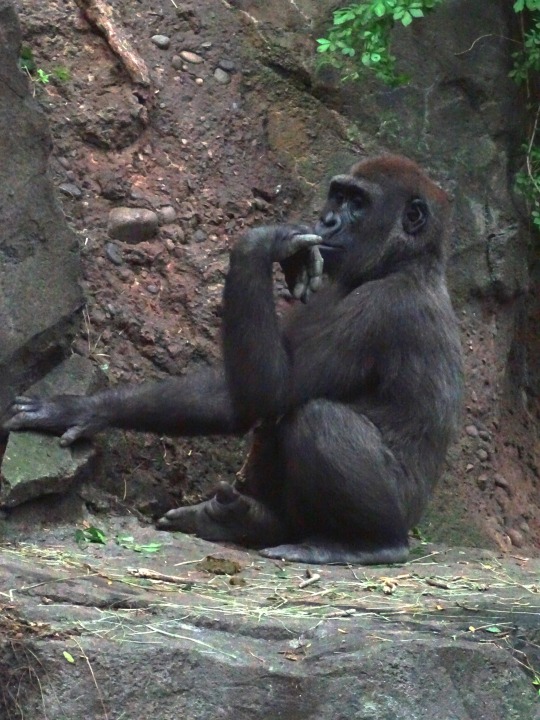

National Zoo Lovers Day
National Zoo Lovers Day, celebrated on April 8 in the U.S. brings all the zoo animal enthusiasts together to celebrate this significant day! Do you know how many animals were saved by zoos from going extinct? Yes, zoos are more than just conservation sites for endangered species, they also provide educational, research, and entertainment purposes. We can trace the history of zoos back to 4000 B.C. If you love animals, then this holiday is just for you. Visit a zoo nearby to find out about your favorite animals; you can also ask to volunteer at a zoo!
History of National Zoo Lovers Day
In the 7th century B.C, the Greeks had the habit of caging animals. ‘Alexander the Great’ sent many animals caught on his military expeditions to Greece. The earlier Egyptian and Asian zoos were kept mainly for public visitors and secondarily used for research purposes. During the 4th century B.C., the Greeks were more concerned with the research and experiment of captivated animals. The Romans had two different animal collections for arena and research objectives.
After the Roman Empire, zoos faced a downfall, but some private collections existed by Emperor Charlemagne in the eighth century and Henry I in the 12th century. King Philip VI had a menagerie in the Louvre, Paris, in 1333. Many members of the house of Bourbon had animal collections at Versailles. Later in 1519, a zoo was discovered in Mexico, which habituated birds, mammals, and reptiles. It was maintained by 300 zookeepers. In 1752, the Imperial Menagerie was founded at the Schönbrunn Palace in Vienna as the first modern-day zoo.
In 1828, two years after the Zoological Society of London was founded, the collection was created in Regent’s Park. By the mid 19th century, zoos were established worldwide. Among the existing zoos of today, more than 40 zoos are 100 years old. Most of these old zoos are in Europe. Since the end of World War II, there has been a fast and worldwide growth of zoos, many of which serve the purpose of public entertainment and economic gain rather than animal research. The exact number of public animal collections across the world today is unknown, although it is believed to be in the thousands.
National Zoo Lovers Day timeline
3500 B.C.
Hierakonpolis Zoo
The strange animal remains discovered near Hierakonpolis, Egypt's ancient capital, suggest the existence of a huge, exotic predynastic zoo.
1500 B.C.
First Real Zoo
Queen Hatshepsut establishes the first real zoo in Egypt.
30 B.C.
The Rise Of Private Zoos
From the shreds of evidence found in Egypt and Mesopotamia, private zoos show status among the wealthy in Rome.
1874
America’s First Zoo
America’s first zoo opens in Philadelphia, Pennsylvania.
National Zoo Lovers Day FAQs
Why do we need zoos?
Zoological gardens are needed to preserve biodiversity. Zoos provide a home to exotic endangered animals and have a history of saving many animals from being extinct.
Why are pet animals not allowed in the zoo?
Pet animals are not allowed in the zoo for various reasons. It can affect the health of zoo animals. Pet animals can be agitated by strange sounds, sights, and smells, which can bring out harm to anyone around.
Can I bring home the adopted animal?
Unfortunately, you cannot. The animals in the zoo cannot be brought up in a domestic household. You will be providing financial support for the animal you have adopted.
How to Celebrate National Zoo Lovers Day
Volunteer: Well, the greatest pleasure you can gain on National Zoo Lovers Day is by volunteering at a local zoo. It is a great opportunity to have a close observation of animals.
A family picnic: A great occasion to have an interesting yet informative family picnic. Take this opportunity to explore unique and exotic animals. You could also share some pictures on social media, spreading the word!
Adopt animals: Many zoos across the world provide animal adoption programs. You can show your love for conserving unique and exotic animals by adopting animals in zoos.
5 Fun Facts About Zoos That’s Sounds Too Good To Be True
Morning walks: Chendra, an Asian elephant in Oregon Zoo, likes to take a morning walk to meet her fellow zoo mates.
Entrance fee: 1/160th of a pound was charged as a zoo entrance fee at The Tower of London back in the 18th century; alternatively, visitors can also provide cats or dogs to feed the lions.
A valorous German Shepard: In 1987, a German Shepherd guard dog defeated an escaped Jaguar in Belgrade Zoo — in this valorous action, the dog saved the life of a zoo employee.
Giant pandas: China contains the ownership of all giant pandas worldwide and they are loaned to other countries at a rental price of one million dollars per pair, per year to raise funds for conservation programs in China.
Disk-throwing chimp: In Sweden, a 30-year-old chimp at Furuvik Zoo collects concrete disks to throw at the visitors.
Why We Love National Zoo Lovers Day
Fun-filled knowledge: National Zoo Lovers day reminds us to explore our local zoos. Every year, millions of people visit zoos and learn about many animals. It also provides a great opportunity for friends and families to have a fun time learning together.
Conserving the endangered: One great thing about zoos is conserving the species at the risk of extinction. An imbalance in biodiversity can bring a disastrous impact on the ecosystem. It reminds us of our responsibility towards nature.
Animal welfare: A wonderful day to remind animal enthusiasts to play their part in animal welfare. An opportunity for providing a large platform to gather support across the world.
Source
#National Zoo Lovers Day#ZooLoversDay#8 April#Bronx Zoo#vacation#my favorite zoo#New York City#summer 2018#2019#original photography#travel#animal#flora#fauna#Grizzly Bear#brown bear#Sulawesi hornbill#lion#inca tern#bald eagle#bird#nile crocodile#tiger#zebra#Silvery lutung#Mandrillus sphinx#Mandrill#close up#USA#tourist attraction
4 notes
·
View notes
Photo

A silvery lutung (Trachypithecus cristatus) in Sabah, Borneo
by Gary Faulkner
#silvery lutung#monkeys#silvered leaf monkey#Trachypithecus cristatus#Trachypithecus#cercopithecidae#simiiformes#haplorhini#primates#mammalia#chordata
16 notes
·
View notes
Text
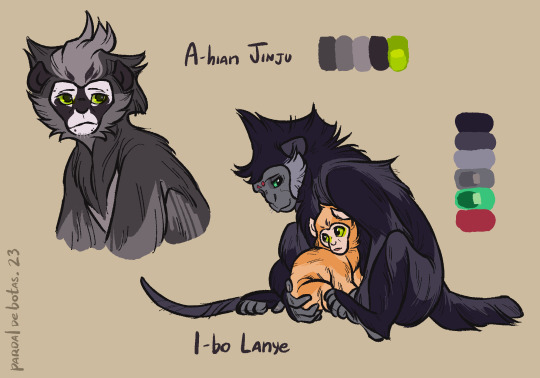

A-hian Jinju, Big Brother Golden-Orange, later Marshal Liu Jinju
(Dusky Leaf Monkey)
Wukong's older brother by age and bond, as they were raised alongside each other. He and Wukong are quite close, and while he has an overall more mellow disposition, he's still quite capable of his own mischief.
Once named Marshal Liu at the return of his younger brother, he wields a Japanese yari, one of the stolen weapons Wukong brings back to Huaguoshan.
He often helps clean up after Wukong's messes in their youth, and once Wukong leaves for his search for immortality, he leaves the troop for a bachelor group. Together they fend off demons and spirits, and despite growing comfortable with being a rebellious leader in his own right, Wukong's return brings him much joy and he gladly bows to his king once more. His own charisma and reputation helped lead many monkeys into Wukong's rule and his support helps solidify the Monkey King's power.
I-bo Lanye, Auntie Orchid-Leaves
(Silvery Lutung)
Biological mother of Jinju and great-granddaughter of Longan, one of Wukong's many many aunties in the troop. She's one of A-ma's favored babysitters to handle Wukong's antics, but she often takes a diplomatic role among their fellow mountain monkeys.
As Wukong builds a proper kingdom at Huaguoshan, she becomes of of the many stewards in Water-Curtain Cave, managing all matters of the mansion on A-ma's name. Everyone knows her word is A-ma's word and even their imp and demon guests know to respect her.
for their names, i played around with google translate and some digging across dictionaries to make a somewhat educated guess of what terms would fit a two-syllable convention. also i'm going for their familial titles in Min Nan Chinese but their names in Mandarin because i'm using Taiwan as inspiration for Huaguoshan and so those terms would have been learned by the monkeys over time out of mostly exposure, while their names were given by either Longan or Wukong, both speakers of Mandarin.
concerning the fact that they are different species, interspecies breeding can sometimes create fertile offspring, as noted in a hybrid discovered recently, but also this is a fantasy story. i'm playing around with monkey species as i go to have some fun with designs and also make the monkeys more diverse and unique.
Jinju uses Japanese weapons because I figure that Wukong went to Japan in order to steal weapons for his monkey army, since it's said that he heads to a kingdom to the east of Huaguoshan and i'm eyeballing some directions to better fit with a real world setting for the story. I tried to place a time for when he'd land, but finding sources for Japanese weapons of that period is a bit hard so I went with my guts and what looked reasonable to expect from the period.
and yes, Jinju is named after the kumquat fruit ajdbjahwbdaw
#jttw#jttw au#jttw oc#xiyouji#journey to the west#marshal liu#Sun clan au#bell dragon art#expedition to the west au
119 notes
·
View notes
Text
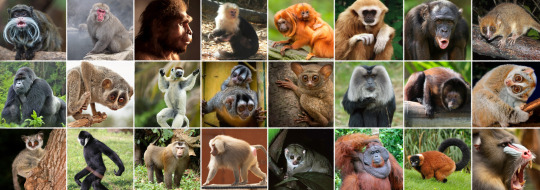
🦍The primate tournament list of candidates has been finalised! Polls will start going up soon!🦧
Thank you to everyone who submitted a species! Here is the full written list:
Basal primates (non-simian primates, including Strepsirrhini and Tarsiiformes)
†Notharctus (Notharctus tenebrosus)
Calabar angwantibo (Arctocebus calabarensis)
West African potto (Perodicticus potto)
Red slender loris (Loris tardigradus)
Bengal slow loris (Nycticebus bengalensis)
Pygmy slow loris (Xanthonycticebus pygmaeus)
Senegal bushbaby (Galago senegalensis)
Brown greater galago (Otolemur crassicaudatus)
Ring-tailed lemur (Lemur catta)
Verreaux’s sifaka (Propithecus verreauxi)
†Archaeoindris (Archaeoindris fontoynontii)
†Megaladapis (Megaladapis madagascariensis)
Madame berthe’s mouse lemur (Microcebus berthae)
Aye-aye (Daubentonia madagascariensis)
Philippine tarsier (Carlito syrichta)
Pygmy tarsier (Tarsius pumilus)
New world monkeys (Platyrrhini)
Wied’s marmoset (Callithrix kuhlii)
Goeldi’s marmoset (Callimico goeldii)
Bearded emperor tamarin (Saguinus imperator subgrisescens)
Golden-headed lion tamarin (Leontopithecus chrysomelas)
Panamanian white-faced capuchin (Cebus imitator)
Central American squirrel monkey (Saimiri oerstedii)
Gray-bellied night monkey (Aotus lemurinus)
Bald uakari (Cacajao calvus)
Madidi titi monkey (Plecturocebus aureipalatii)
Atlantic titi monkey (Callicebus personatus)
Black bearded saki (Chiropotes satanas)
White-faced saki (Pithecia pithecia)
Colombian red howler (Alouatta seniculus)
Brown spider monkey (Ateles hybridus)
Northern muriqui (Brachyteles hypoxanthus)
Yellow-tailed woolly monkey (Lagothrix flavicauda)
Old world monkeys (Cercopithecidae)
Mantled guereza (Colobus guereza)
Zanzibar red colobus (Piliocolobus kirkii)
Nepal gray langur (Semnopithecus schistaceus)
Silvery lutung (Trachypithecus cristatux)
Golden snub-nosed monkey (Rhinopithecus roxellana)
Proboscis monkey (Nasalis larvatus)
Red-shanked douc (Pygathrix nemaeus)
Collared mangabey (Cercocebus torquatus)
Japanese macaque (Macaca fuscata)
Rhesus macaque (Macaca mulatta)
Hamadryas baboon (Papio hamadryas)
Mandrill (Mandrillus sphinx)
Gelada (Theropithecus gelada)
Common patas monkey (Erythrocebus patas)
Bale mountains vervet (Chlorocebus djamdjamensis)
De brazza’s monkey (Cercopithecus neglectus)
Apes (Hominoidea)
Lar gibbon (Hylobates lar)
Pileated gibbon (Hylobates pileatus)
Kloss’s gibbon (Hylobates klossii)
Northern white-cheeked gibbon (Nomascus leucogenys)
Siamang (symphalangus syndactylus)
†Junzi (Junzi imperialis)
Bornean orangutan (Pongo pygmaeus)
†Gigantopithecus (Gigantopithecus blacki)
†Dryopithecus (Dryopithecus fontani)
Western lowland gorilla (Gorilla gorilla gorilla)
Chimpanzee (Pan troglodytes)
Bonobo (Pan paniscus)
†Australopithecus (Australopithecus afarensis)
†Panranthropus (Panranthropus boisei)
†Flores hobbit (Homo floresiensis)
†Neanderthal (Homo neanderthalensis)

The first set of polls will go up as soon as I have finished writing the descriptions! In the meantime, I would appreciate if you could share this tournament around- it won’t be much of a tournament if there aren’t that many people voting! In going down the research rabbit hole I’ve found so many interesting species and stories, and I promise learning about them here will be worth your time!
#primate bracket#tournament#tumblr tournament#poll#polls#primate#primates#extinct primates#biology#animals#zoology#please let me know if I made a mistake anywhere!
97 notes
·
View notes
Photo

really quick monkey studies for monkey day!!
#monkey#silvery lutung#snow monkey#rhesus monkey#capuchin monkey#spider monkey#original#myart#study#u can tell i gave up on these KLWHGELKHJEWG
284 notes
·
View notes
Note
How would you describe someone with a silvery lutung daemon? What about a Pacific gull, if I may ask two? :D
Hey there! Hope you don’t mind if these are a little shorter, there’s still some gaps in the research on them (and I also suck at primate analysis orz)
A silvery lutung looks pretty group-oriented and socially-tolerant most of the time. They can be the altruistic/empathetic type for those in their group, but I wouldn’t call them particularly close-bonding. They also have a possessive/defensive streak when their boundaries are crossed. Overall they’re more peaceful than many in the primate family. They’re also one of the less vocal monkeys as well, though they value communication.
The pacific gulls are also pretty socially-tolerant, although they feel more comfortable in pairs/loose groups (most likely save their close bonds for very few). They’re curious and inquisitive people who are pretty resourceful as well. They’re also really adaptable and flexible, but also appreciate familiarity. These are also the type of workers to share work equally and do their part dutifully.
2 notes
·
View notes
Photo
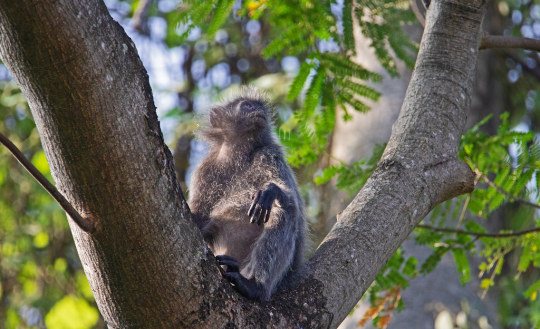
Silvery lutung (Trachypithecus cristatus) - KL Forest Eco Park - Kuala Lumpur, Malaysia - Jan 2020 by Dis da fi we The silvery lutung (Trachypithecus cristatus), also known as the silvered leaf monkey or the silvery langur, is an Old World monkey. It is arboreal, living in coastal, mangrove, and riverine forests in Peninsular Malaysia, Sumatra, and Borneo. Silvery lutungs are unusually susceptible to human diseases, including AIDS, and have therefore been widely used in medical research. https://flic.kr/p/2jwMv6d
2 notes
·
View notes
Photo

Silvery lutung (Trachypithecus cristatus) - KL Forest Eco Park - Kuala Lumpur, Malaysia - Jan 2020 by Dis da fi we The silvery lutung (Trachypithecus cristatus), also known as the silvered leaf monkey or the silvery langur, is an Old World monkey. It is arboreal, living in coastal, mangrove, and riverine forests in Peninsular Malaysia, Sumatra, and Borneo. Silvery lutungs are unusually susceptible to human diseases, including AIDS, and have therefore been widely used in medical research. https://flic.kr/p/2jwMv6d
0 notes
Photo

Silvery lutung (Trachypithecus cristatus) at Kinabalu Park in Malaysia
Barbara Evans
26 notes
·
View notes
Video
silvered leaf monkeys/ silvery lutung/ silvery langurs in bronx zoo’s jungle world
7 notes
·
View notes
Photo
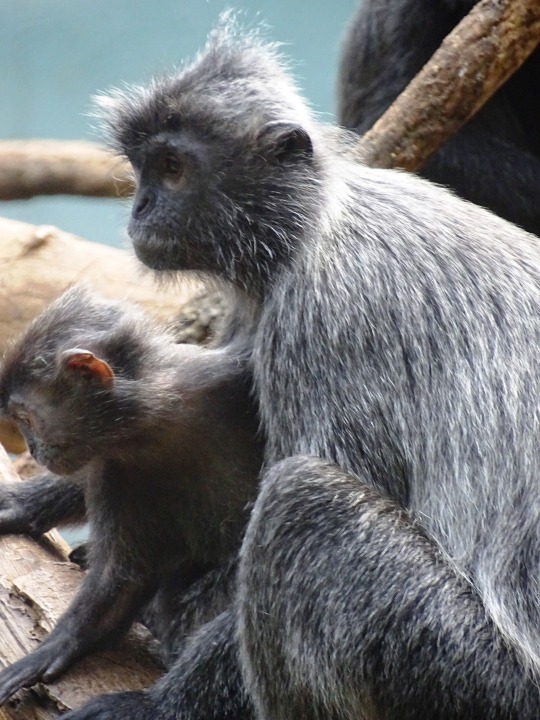



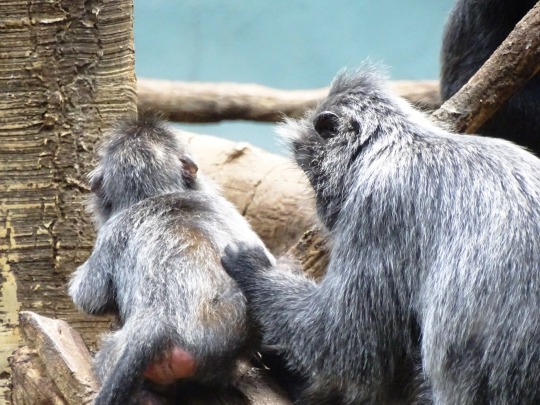





Bronx Zoo, New York City (No. 45)
Silvery lutungs are diurnal, and travel in groups of around 9-40 individuals with one adult male and many adult females communally caring for infants. They rarely leave the trees, which provide them protection from ground-dwelling predators, and rapidly flee if threatened. Each group occupies a home range of 20 to 43 hectares (49 to 106 acres), although these may overlap with those of neighbouring groups. During the day, individuals may travel up to 500 metres (1,600 ft) through the forest, with some forming all-female subgroups that separate from the group containing the male. The entire group shelters in a single tree at night.
The social structure of silvery lutungs is matrilineal and harem based. Females remain in the group for life, while males leave shortly after reaching adulthood, living in small groups of their own until they can take over an established harem. Within the group, males dominate the females, and females with young dominate those without. However, there is relatively little aggression within the group compared with some related species.
Because group ranges often overlap, different groups frequently come into contact with one another. The adult male protects his group and territory from competing males, communicating his dominance to other males via vocalizations and fighting. In the absence of males, however, females from different groups are more likely to interact peacefully. The most serious conflicts occur when a male intrudes directly on the territory of another male, which may result in the intruder displacing the resident and taking control of the group. In many other primates, such a displacement would normally be followed by the male killing any infants sired by his predecessor; although this may occur in silvery lutungs, it has not been directly observed, and may be less common than in some other species.
Although less vocal than other closely related species, silvery lutungs make at least thirteen different vocalisations, with the most common being used by adult males defending their territory. Other vocalisations express fear, anger, excitement, and satisfaction, in addition to various calls made by infants.
Source: Wikipedia
#Bronx Zoo#my favorite zoo#New York City#Old World monkey#animal#USA#travel#summer 2018#original photography#vacation#JungleWorld#indoors#tourist attraction#Wildlife Conservation Society#WCS#Silvery lutung#silvered leaf monkey#silvery langur#female#young#louse#flora#fauna#nature#Northeastern USA#borough
4 notes
·
View notes
Video
In Cambodia the @wildlife_alliance releases a gibbon family into the wild along with some silver langurs also called the silvered leaf monkey or silvery lutung. This is a #repost from @wildlife_alliance via @PhotoAroundApp This little baby gibbon is now two years old and a second gibbon has been born at Angkor! They are the first two gibbons born to reintroduced parents in Cambodia - a major success for these endangered apes! #Wildlife #Angkor #Conservation #PrimateConservation #angkorwat #gibbon #gibbons #langur #ape #UNESCO #unescoworldheritagesite #release #endangeredanimal #cute #babyanimal #adorable #babymonkey #wild #wildlifealliance #apeconservation https://www.instagram.com/p/B2znqHvg2oR/?igshid=kgtvu778f13n
#repost#wildlife#angkor#conservation#primateconservation#angkorwat#gibbon#gibbons#langur#ape#unesco#unescoworldheritagesite#release#endangeredanimal#cute#babyanimal#adorable#babymonkey#wild#wildlifealliance#apeconservation
5 notes
·
View notes
Video
Silvery Lutung by Our Breathing Planet
Via Flickr:
The Silvery Lutung is a species in the genus: Trachypithecus. This is a group of Old World monkeys. Their endemic range consists of two regions. One portion of this range consists of southern India and Sri Lanka. The other region entails much of southeast Asia. As infants, the fur of this animal is typically a golden yellow in color. The mother of a newborn Silvery Lutung shares the duties of raising the infant with other females of the group she is part of. The Silvery Lutung reaches maturity within 4-5 years. A typical life expectancy in the wild is approximately 20 years. Silvery Lutung Physical Characteristics The general physique of the Silvery Lutung is very slim. They also possess a comparatively long tail. The coloring of the fur will vary from one species to another. These colors include orange yellow, black, and gray. The structure of the hair on the head of a Silvery Lutung is often compared to a hood. The arms are generally much shorter than the legs. An average adult will stand approximately 31.5 in (80 cm) tall. Weights vary significantly between species. This range is typically between 11-33 lb (5-15 kg). Displaying sexual dimorphism, the males are generally larger than the females. Silvery Lutung Habitat and Behavior The Silvery Lutung prefers to inhabit regions of rainforest. However, they may occasionally be found in secluded mountain forests as well. They generally spend the majority of their day in the trees. There, the Silvery Lutung commonly crawls along the branches. They will occasionally leap from tree to tree. They are diurnal in nature. Typically, the are more active in the mornings and afternoon. The Silvery Lutung will usually live in groups ranging in size from 5-20 individuals. They are entirely herbivorous. Their diet principally consists of fruits, leaves, and buds. #ourbreathingplanet Photo Source:http://en.wikipedia.org/wiki/Lutung#mediaviewer/File:Duskyleavemonkey1.jpg Photographer: Robertpollai
0 notes
Text
Sun clan AU character directory
[this directory will be edited and updated as time goes on and the story progresses]

THE ELDERS: older generation, live on the deeper chambers of the Shuilian Mansion and enjoy the respect and honors by all the beings in Huaguoshan.
An-kong Tudigong (Grandpa Earth God)
Earth God of Huaguoshan, appears mostly as a moss-green furred orangutan but has many forms. Reclusive and reticent, but loves dearly all the beings living on his mountain. Adoptive father of Wukong.
A-ma Longan (Grandma Dragon-Eye)
Matriarch of a monkey troop, Francois Langur. Dry yet caring, often serves as a protector of the monkeys of the mountain and a middleman between spirits and mortal creatures. Her duties were mostly taken over by Wukong after he became king. Adoptive mother of Wukong.
I-bo Lanye (Auntie Orchid-leaves)
Granddaughter of Longan, and second in command, Silvery Lutung. Fond and overbearing, takes care of the troop whenever Longan leaves to maintain the peace. Biological mother of Jinju.
Shandanmao (Coral lily cat), also called Au-bo Shanhu (Stepmom Coral)
An asian golden cat who once attempted to eat Longan, and was made to atone for her attack on the mountain's Tudipo by serving as her bodyguard.
Wukong, also called Shihou (Stone Monkey) and Xiaoshi (Little pebble)
King of Huaguoshan. Rules over several troops that live on the mountain and shelter in the Water-Curtain Cave, and helps to keep the peace and balance among the creatures and demons.
THE FOUR STALWART MARSHALS: The Monkey King's trusted second-in-commands in the kingdom's hierarchy, and Wukong's closest confidants.
Liu Jinju (Golden-Orange)
Ma Yuehua (Moon-Flower)
Ba Hongteng (Red-vine)
Beng Maqaw (Mountain-pepper)
THE GOLDEN CAPTAINS: Trusted soldiers directly under the command of the Stalwart Marshals, but especially under Jinju/Marshal Liu
Songzhen (Pine-needles)
Second-oldest of the group, a laidback Ebony Javan Langur.
Suanguo (Sour-fruit)
The youngest and grumpiest of the bunch, a red-shanked douc.
EXTENDED FAMILY: Members of the sworn brothers' kingdoms who end up joining Huaguoshan in some manner.
Erwangzi Xiangjing (Second Prince Fine-Fragrance), also known as Prince Rougui (Cinnamon)
Wukong's mate and trusted friend, Cat Ba langur. One of the rescued monkeys from the Monstrous King of Havoc's lair, trusted advisor and cousin-in-law of Yurong Wang (Golden Snub-nosed Monkey King). Charming, eloquent and wise, but wears his heart right on his sleeve. After the two kings build an alliance, Xiangjing and Wukong become quite fond of each other, and after some failed courting attempts, Wukong accepts Xiangjing's affections.
Rinrin, also called Xiaohuo (Little fire)
Ranked sentry and scout, Rhesus Macaque demon. Once part of Niu Mowang's kingdom, she sought to earn further rank and merit by learning exorcism techniques to dispel minor demons who'd dwell on the edges of the mountains. She became emotionally attached to a human demon hunter, and when she left the mountain in shame, said human followed her. She earned the friendship of Wukong swiftly, which also earned her a spot in his court despite displeasing the Bull Demon.
Xiaojie Duan
Skilled demon hunter, human. While she's accomplished in exorcising and conquering demons and spirits, her true goal was to find someone she loved to settle down and raise a family with. What luck, that said person turned out to be a demon monkey in disguise! Not one to back down from her affections, she followed after Rinrin and together they settled in Huaguoshan.
THE SEVEN PRINCELINGS: Wukong's children by order of age.
Wumiao (Witch-sprout)
Adopted first daughter, fairy crane demon. Eternally youthful and ethereally beautiful lady. Often bears a feathered fan in her hand and a pinewood sword at her waist. Gentle and demure, adores her father and siblings. Head priestess of the Huaguoshan Daoist temple, and protectress of the Heavenly gate there.
Bailian (White-face)
The largest of the quintuplets, Bailian has snow-white pale skin no matter the season or weather, and fur like clouds at dusk. Despite being the firstborn son and the only one able to walk on clouds and water, Bailian has frail health and a sickly disposition, and thus seldom interacts with the world at large. His father and siblings tend to be overprotective due to this, much to his dismay.
Liangwei (Two-tails)
The second daughter, Liangwei has a head of golden fur and two prehensile tails. She has a cunning mind and a sharp tongue, always quick to reply and twist people into knots with her words. She enjoys entertaining guests and kindred with masterful poetry and rhymes, as much as others enjoy hearing her. Her eyesight is quite poor, and she often relies on Sanyan and her tails to help her find her way around.
Sanyan (Three-eyes)
Second-born son, with a somber and dry temperament. Though his appearance seems at first not to stand out against his more visibly magical siblings, Sanyan possesses a third eye often hidden in his fur when closed. It can see the true nature of all things, though what he knows he seldom shares. Sanyan is selectively mute, and communicates through sign language or by borrowing Liangwei's sharp tongue when she's around.
Shuashua (Playful):
Third son among the five, and by far the most energetic. Most well known as a never-still blur, Shuashua is nimble and covered in colorful stripes of fur and has a snub nose. He's known for never sleeping or ever seeming to rest at all, and spending most of his time with some activity or another. Not the sharpest tool in shed, but his bright and hard-working disposition more than makes up for it.
Si'er (Four-ears)
Third daughter, and by all measures the runt of the quintuplets. She has a calm and sweet disposition, but her particularity of having four calf-like ears and sensitive hearing often tends to put off the others of her family and kingdom. Reincarnation of [redacted], aware of past life. Deeply devoted daughter and sister, tries her best to right the wrongs of the past. Has terrible tinnitus and migraines that turns her physically monstruous. Keeper of the sealed temple of [redacted].
Danxia (Cinnabar Cloud)
Adopted fourth son, human. An orphan left in Wumiao's temple. Despite growing up surrounded by demons, immortals, and fairies, the boy had no contempt for his peers, instead striving to learn as much as he could to keep up with his siblings.
THE KING'S DISCIPLES: newcomers to Huaguoshan after the fire, brought in thanks to the pilgrimage west.
Xiaoyu (little fish), Congcong (verdant), Jiazao (hearth)
Three female macaques Wukong rescued from being stable monkeys, and have stuck to the group to cater to the artifacts and run minor errands. Trained in combat by Wukong, and later joined the mountain kingdom as warrior nuns and established a Buddhist temple.
29 notes
·
View notes
Text
Round 1, part 2, match 2: langurs
Nepal gray langur (Semnopithecus schistaceus)
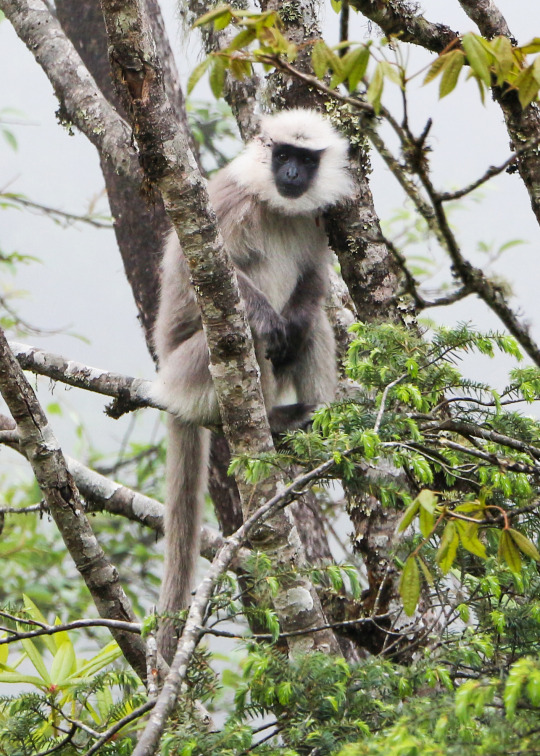
One of a few primate species to live outside the tropics, the Nepal gray langur lives in the high-altitude forests of the Himalayas. They are semi-arboreal, and relatively adaptable in terms of habitat. They eat mostly leaves and fruits, but have also been reported licking stones, eating soil, and even eating charred bones, all to obtain important dietary minerals. They’re also one of many non-human species documented to engage in homosexual sex!
Silvery lutung (Trachypithecus cristatux)
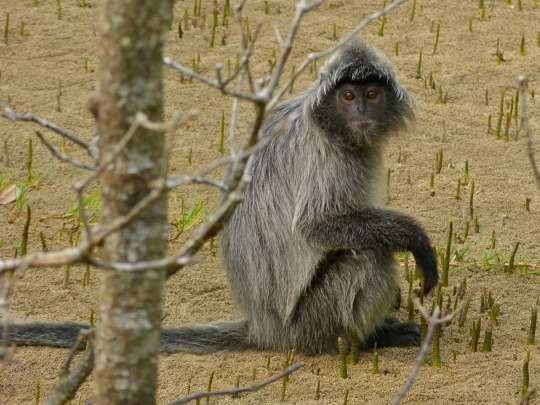
This arboreal monkey is found in wetland forests, including mangroves, coasts, rivers, and swamps, across several Indonesian islands. They are far more specialised for eating plants than most primates, with ridged teeth and a multi-chambered stomach. Juvenile silvery lutungs are bright orange, a stark contrast to their adult grey colour.
13 notes
·
View notes
